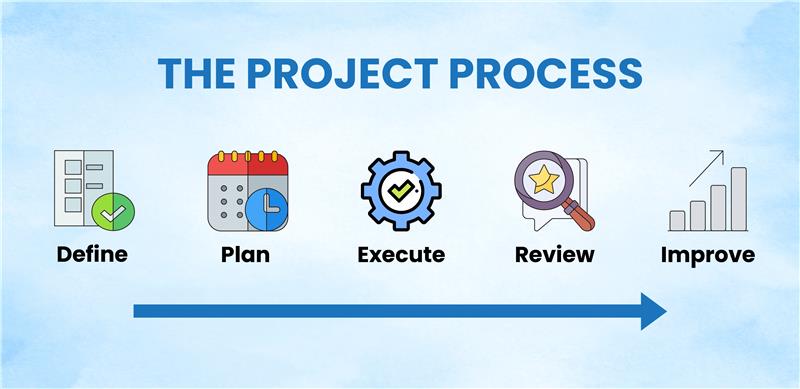The Foundation Most Teams Ignore
Behind every successful project is one simple thing: process thinking in project management.
Yet many teams skip this step. They jump straight into tasks, improvise when problems arise, and assume things will somehow work out. That’s when projects stall, budgets spiral, and people burn out fixing preventable mistakes.
The problem isn’t usually skill or effort. It’s that no one stopped to define how the work should actually happen.
What Really Happens When There’s No Process
When there’s no structured way of working, projects quickly lose direction. People focus only on their own tasks, with little idea of how their work connects to others. Plans become guesswork. Deadlines slip. Costs increase.
Take scope as an example. If you don’t clearly define what needs to be done from the start, everything that follows—planning, timelines, budgets—becomes unreliable. One gap at the beginning spreads through the entire project.
It’s not about technical ability. It’s about working without a clear map.

Process Thinking in Project Management Makes Work Easier
A lot of people hear “process” and think of red tape. But process thinking in project management isn’t complicated—it’s practical.
It’s about knowing the steps, who’s responsible, and how each part connects to the bigger picture.
In technical fields, some still believe good work comes purely from creativity and intuition. But the best results come from combining that creativity with structure. When everyone understands the process, you get fewer surprises, fewer last-minute fixes, and a smoother path to completion.
How to Build a Process-First Approach
If recurring problems keep showing up, chances are the process is broken—or missing entirely.
The first step? Map what’s really happening now. See what happens at each stage, where things slow down, and what causes confusion.
From there, make small, continuous improvements. Processes aren’t meant to be fixed forever—they should adapt as projects, teams, and tools change.
To dive deeper into process groups, explore PMI’s guide to project management processes.
Why Strong Processes Give You an Edge
Here’s what good processes do:
- They make everyone’s role and responsibilities clear.
- They prevent the same mistakes from repeating.
- They make projects more predictable and less stressful.
Far from limiting creativity, a clear process gives teams the space to focus on what they do best—without constant firefighting.
Final Thoughts
Projects don’t succeed because people push harder or stay up late fixing mistakes. They succeed because the work follows a clear, thought-out process that keeps things moving in the right direction.
If you want fewer headaches, fewer surprises, and better outcomes, start by embracing process thinking in project management. You can also explore our PMP Certification Training to gain the right guidance for applying these practices effectively.









Informative, Interesting, and Brief Analysis on Process thinking. I have been reading your short briefings related to Project management, and find it very Interesting. These articles can be presented as a collection for Project managers and used as a quick reference guide. To start with, you can release the First Part of say 25 Chapters, as a Pdf document, and follow it up with more releases.
Looking forward to more such contributions from INFOCAREER.
Thanks
Shivkumar
9382199388